" Your Satisfaction Is Our Goal "
(021) 5154560 (021) 5154561
081310787177 (Products)

![]() INTRINSIC SAFETY DOWNLOAD CATALOG
INTRINSIC SAFETY DOWNLOAD CATALOG
EX DESIGNATION
EXPLOSION PROTECTION
The important principles for integrated safety explosion protection are as follows:
This differs from:
| Definition in accordance with 1999/92/EC Directive (ATEX 153) | Reference values (not standardised) | Zone | A device from the following device category must be used (see 1999/92/EC-ATEX 153 Directive) | e |
|---|---|---|---|---|
| Area in which a potentially explosive atmosphere as a mixture of air and flammable gases, vapours or mists is present either frequently or over a prolonged period. | P>1000 h/a | 0 | 1 | G |
| Area in which under normal operation a potentially explosive atmosphere as a mixture of air and flammable gases, vapours or mists can occasionally form. | 10…1000 h/a | 1 | 2 (1G also possible) |
G |
| Area in which under normal operation a potentially explosive atmosphere as a mixture of air and flammable gases, vapours wor mists is not normally present but may occur for just a short period. | <10 h/a | 2 | 3 (1G, 2G also possible) |
G |
| Area in which a potentially explosive atmosphere in the form of a cloud of flammable air-borne dust is present either constantly, over prolonged periods or frequently. | 1000 h/a | 20 | 1 | D |
| Area in which under normal operation a potentially explosive atmosphere in the form of a cloud of flammable air-borne dust can occasionally form. | 10…1000 h/a | 21 | 2 (1D also possible) |
D |
| Area in which under normal operation a potentially explosive atmosphere in the form of a cloud of flammable air-borne dust is not normally present although may occur for just a short period. | <10 h/a | 22 | 3 (1D, 2D also possible) |
D |
DIVISION INTO TEMPERATURE CLASSES
The temperature class indication can be guaranteed only if the ambient temperature specified for the operating device is respected (see Technical Data or Rating Plate). Strict compliance is a mandatory requirement.
| Temperature classes of flammable gases and vapours and permitted surface temperatures of the operating device in accordance with DIN EN 50014 |
||||||
|---|---|---|---|---|---|---|
| Temperature class | P>T1 | T2 | T3 | T4 | T5 | T6 |
| Ignition temperature in °C | >450 | >300 | >200 | >135 | >100 | >85 |
| Maximum temperature in C° | 450 | 300 | 200 | 135 | 100 | 85 |
| Examples | Propane Methane Amoniac |
Ethylene Alcohols Acetylene |
Petrol Solvents |
Ethylether Acetaldehyde |
- | Carbon disulphide |
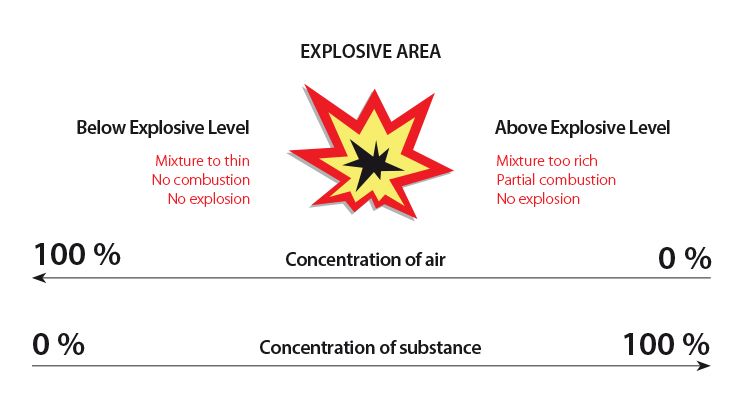
Explosions are dependent on many parameters:
Only for atmospherical conditions and pure substances sufficient comparative values and data are shown. An explosion can only occur where a flammable substance in the form of gases, vapours, smoke and dust exists along with sufficient oxygen to support -combustion and there is a source of ignition.
E.g.:
FUNDAMENTS OF DUST EXPLOSION PROTECTION
TYPES OF IGNITION PROTECTION
DIVISION INTO ZONES
 |
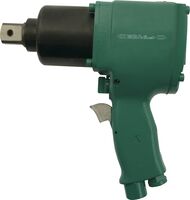 |
 |
 |
| PERCUSSION | IMPACT WRENCHES | TORQUE WRENCH | SAWS |
| PNEUMATIC,HYDRAULIC... | PNEUMATIC, HYDRAULIC... | PNEUMATIC... | PNEUMATIC, HYDRAULIC... |
 View All View All |
 View All View All |
 View All View All |
 View All View All |
 |
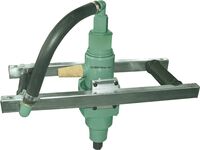 |
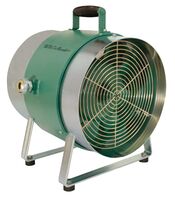 |
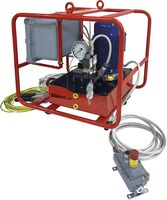 |
| CUTTING AND BEVELLING MACHINE | MIXER | FAN | POWER UNIT PUMP FOR HYDRAULIC TORQUE WRENCHES |
| HYDRAULIC... | PNEUMATIC... | AXIAL,VENTURI... | ELECTRIC DRIVE... |
 View All View All |
 View All View All |
 View All View All |
 View All View All |
![]() INTRINSIC SAFETY DOWNLOAD CATALOG
INTRINSIC SAFETY DOWNLOAD CATALOG